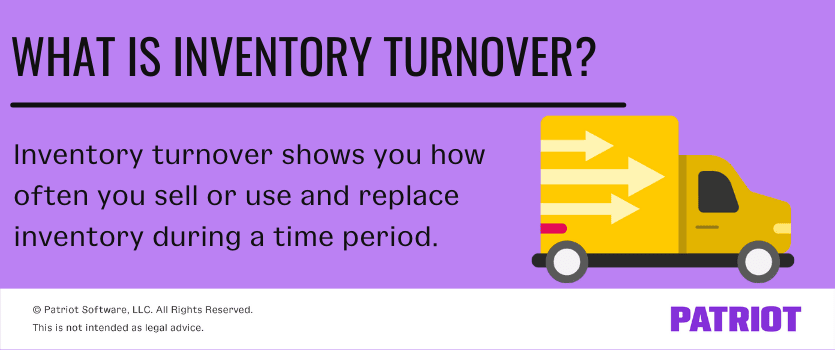Think you’re doing too much purchasing and not enough selling? Or, think you’re selling too much and not buying enough? There’s only one way to be sure, and that’s by finding your inventory turnover ratio.
What is inventory turnover?
Inventory includes all the goods you have for sale and in storage, such as raw materials, items in the production process, and finished goods. Inventory turnover is a type of ratio that shows you how efficiently you manage that inventory. The inventory turnover ratio, or stock turnover ratio, tells you how often you sell or use and replace inventory during a time period (e.g., month).

Your ratio may tell you that you:
- Purchase too much inventory (i.e., overstock)
- Don’t buy enough inventory to keep up with demand (i.e., understock)
If you purchase too much inventory, you could have goods sitting endlessly on a shelf. And nobody wants that (especially if those goods are perishable!). On the other hand, you may sell out of inventory too quickly and have to turn away customers until you can restock. Nobody wants that, either (especially if they turn to your competitors in the meantime!).
Use your inventory turnover ratio to help make well-informed decisions on product pricing, what products you offer, marketing efforts, and purchasing timing.
Inventory turnover vs. shrinkage
Some business owners confuse inventory turnover with inventory shrinkage. Whereas turnover measures how quickly you sell (or use) inventory, shrinkage tells you how much inventory you lose.
Inventory shrinkage shows you how much inventory you lose as a result of theft, damage, recordkeeping errors, or vendor fraud.
So, shrinkage may dictate how quickly you need to replace inventory in a period. And, having too much shrinkage could hurt your business’s turnover ratio (since you aren’t selling or using those items). But, turnover and shrinkage are not one and the same.
How to calculate inventory turnover ratio
Ready to calculate your business’s inventory turnover ratio? First, determine what time period you want to use. Then, you need to know your business’s cost of goods sold (COGS) and average inventory during that period (aka the mean value of inventory).
To get the ratio, use this magical inventory turnover formula:
Inventory Turnover Ratio = Cost of Goods Sold / Average Inventory Value
Want to know how long you have inventory on hand for? You can divide 365 days a year by your ratio (365 / ratio).
Example
Let’s say you want to find your inventory turnover ratio for the past year. During that period, your cost of goods sold equaled $60,000. And, your average inventory was $8,000.
To find your stock turnover ratio, divide your cost of goods sold by your average inventory:
Inventory Turnover Ratio = $60,000 / $8,000
Inventory Turnover Ratio = 7.5
Your inventory turnover ratio of 7.5 shows that you “turned over” your inventory 7.5 times in the past year. This shows you held onto inventory for around 48.7 days (365 / 7.5).
So … is that good?
What is a good inventory turnover ratio?
Again, your inventory ratio shows you the number of times you sell or use and restock inventory during a period. So generally, a higher ratio (e.g., 5) is better than a lower ratio (e.g., 1). It indicates that you are selling or using inventory more quickly than a lower ratio.
A high ratio may indicate:
- Strong sales
- Understocking
- Poor pricing (i.e., pricing too low)
A low ratio may indicate:
- Weak sales
- Overstocking
- Poor pricing (i.e., pricing too high)
However, keep in mind that a “good” ratio may depend on your industry. For example, a company that sells higher-end items would likely have a lower ratio than a grocery store.
Join the club!
Get the latest accounting news delivered straight to your inbox.
Subscribe to Email ListWhat to do if your stock turnover ratio is too high or too low
Think your stock turnover ratio is too high or too low? There are some steps you can take to make it just right.
If your inventory turnover ratio is too high or too low, you can take actions like:
- Adjusting pricing
- High ratio: Selling your inventory too quickly? Your pricing may be too low (not that your customers are complaining!).
- Low ratio: Having trouble selling your inventory? Your pricing may be too high for your target market.
- Finding a new supplier
- High ratio: Supply chain issues could lead to trouble stocking your shelves to meet demand.
- Low ratio: Maybe you have problems selling inventory because the goods you receive just aren’t cutting it. You might consider finding better quality items from a new supplier.
Before you make drastic measures to improve your ratio, take a step back and consider your business’s specifics. Sometimes, having a too-high ratio is good, like if you just had a major sales event to get rid of old stock. Likewise, having a too-low ratio can be good if you overstock to avoid upcoming supply shortages.
Want to lower the chances of too-high or too-low stock turnover ratios? Consider spending more time demand forecasting. Demand forecasting can help you predict future customer demand and sales. For example, you may discover that there’s going to be an increase in demand for Product XYZ due to market trends and conditions. And if that’s the case, you’d want to stock up.
Other business ratios you should use
The stock turnover ratio isn’t the only one you should use to make business decisions. Other financial ratios you should familiarize yourself with and use include:
- Current ratio (or working capital ratio): How do your assets compare to your business’s liabilities?
- Quick ratio: Are you able to pay your short-term liabilities?
- Return on investment (ROI) ratio: How much money does an investment bring in compared to what you paid for it?



